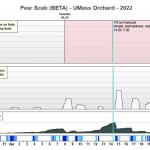Pear IPM - Pear Scab
Overview
Pear Scab is a fungal disease caused by Venturia pirina pathogen that can affect the leaves, shoots, and fruit of pear trees. Like apple scab (V. inaequalis), pear scab creates lesions on leaves and fruit which impact overall tree health and fruit production.
ID/Life Cycle:
Pear scab often appears first on undersides of leaves as small yellow, or chlorotic spots. It can be hard to notice on leaves. On fruit, these same patches appear larger and are more obvious. Given time, infections will turn black and soft. Pseudothecia over winter in infected leaves. Ascospores develop in pseudothecia in spring and are released with rainfall of at least 0.01 inches. Once ascospores have been released and land on susceptible tissue, it must remain wet for at least 9 hours at 59-77ºF for infection to occur. Wind or water carries these spores from previously infected leaves to the rest of the tree, landing on leaves, flowers, and fruit. Unlike apple scab, pear scab spores can release at night. Conidia appear between 8 and 20 days after initial infections occur, optimal temperatures between 50℉ and 75℉.
Damage:
V. pirina can cause a tree to drop its leaves, flowers, and fruit prematurely. In severe cases of
early leaf infection, defoliation will happen, which leads to further problems. Leaves and flowers are crucial to the development of healthy fruit on a thriving tree.
Pear Scab lesions can occur on the shoots, leaves, and fruits. All lesions start as olive-colored circular spots that transition to dark brown as the infection progresses. Shoot lesions are usually easily visible. They can be walled-off or sloughed off the shoots. On leaves the lesions are more visible on the bottom of the leaf, but overall can be hard to identify. Since spores on leaves are a major transporter of the pathogen it is important to identify it and work to eliminate it. Often times infected fruit will crack open from the lesions on the skin, leading to fruit malformities, making the crop unsellable. Secondary infections, or infections that occur later in the growing season, are less severe, and the lesions are smaller and less likely to spread.
Management Strategies
Monitoring:
RIMpro, is an online decision support system developed by agronomist Marc Trapman. This system contains a model to estimate development of V. pirina conidia and potential host susceptibility.
Cultural/Biological
Breaking up residues like leaves and branches from previous growing seasons, by using a mower or other
mechanical means, reduces the amount of inoculum present. Pear Scab overwinters in lesions on branches and stems, as well as any infected dead leaves or debris that have fallen off trees. If pear scab has been a present, chemical controls may be needed.
Application of urea or other nitrogen-based fertilizer to leaves in late fall will reduce inoculum by breaking down leaves more quickly. Applying lime prior to leaf fall will also reduce overwintering inoculum.
Pear varieties with reduced susceptibility include Barnett Perry, Batjarka, Brandy, or Erabasma, however, few of these cultivars are grown in most New England orchards. While Asian pears are not susceptible to V. pirina, they are susceptible to V. nashicola.
Chemical
- Fungicides are the most commonly available and economically effective method to manage pear scab. Many are the same used to control apple scab infection. Protective fungicidal applications are made in advance of estimated rain events. Infection risk occurs between delayed green tip and petal fall.
- Propiconazole, Myclobutanil, Tebuconazole.
- NETFMG spray table
- Organic options are available, such as copper octanoate (copper soap), sulfur, Bordeaux mixtures, and mineral oil or neem oil. Be sure to check labels to verify specific formulation may be used in organic systems.
- Copper and Bordeaux should not be applied after bloom, as russeting, may occur. They should only be applied between green tip and full bloom.
- Refer to the New England Tree Fruit Management Guide for specific materials and rates recommended for managing Pear Scab.
Date: December 2021
Author(s): Patrick Stringer, Jaelyn Kassoy, Elizabeth Garofalo Stockbridge School of Agriculture, Extension Fruit Program


